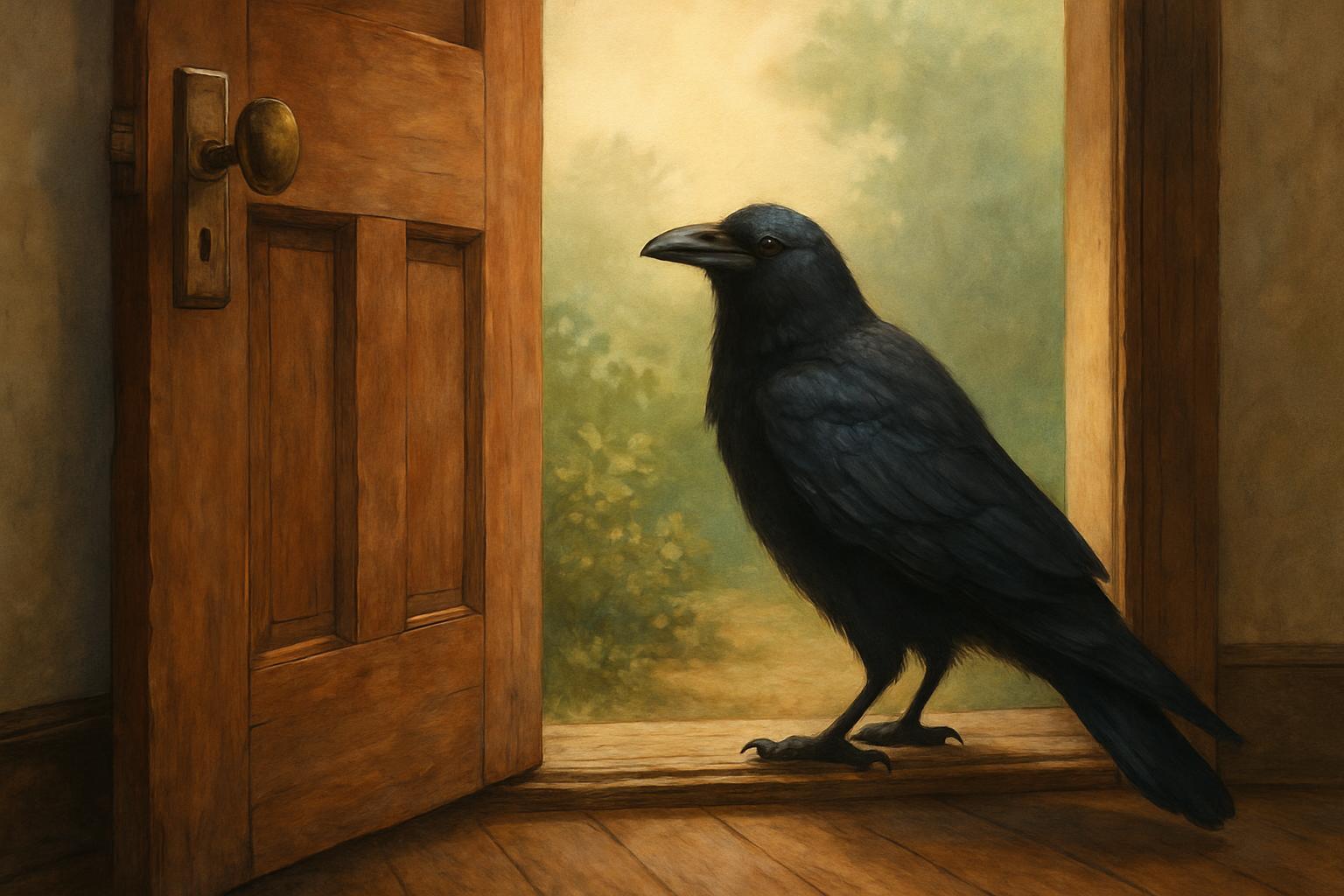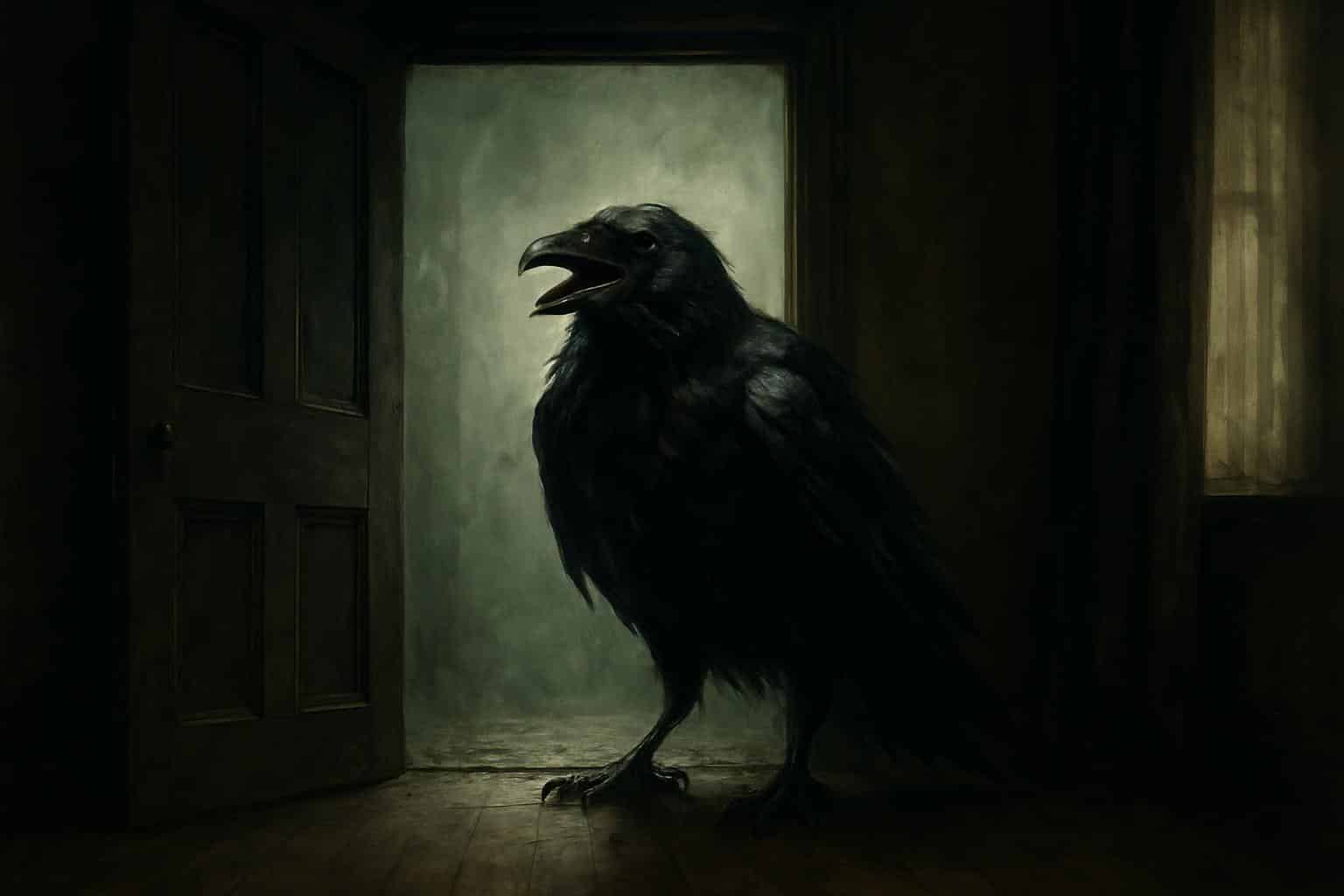As adapted by Dylan Southern from Max Porter’s widely acclaimed novella of the same title, it comes as a bruising, ink-dark meditation on bereavement (not a sorrowful mood but, indeed, a creature). Benedict Cumberbatch stars as a widowed father menaced by a hulking, wheezing crow in this visitation that turns the family home into a battleground where memory, fantasy and survival scratch at one another. It’s a bold, unwieldy film (let’s hear it for those) that treats sorrow as something you negotiate, not simply narrate.
A Crow Who Talks Back: Grief’s Tormentor and Guide
Porter’s text — winner of the International Dylan Thomas Prize — gave grief a beak, talons and a foul mouth. Southern respects that conceit without adhering to it slavishly, distilling the book’s polyphony into a cinematic duet between Dad and the Crow. Voiced with mordant relish by David Thewlis and physically embodied by Eric Lampaert, the bird is a tormentor, a trickster and therapist in equal measure. He gets excellent support from the filmmakers in demolishing “the neatness of human sadness,” shape-shifting between threat and jester in a snap, and the editing — cut with a serrated edge by George Cragg — allows his freewheeling, stream-of-consciousness patter to peck away at Dad’s composure until it shatters.

The creature work relies on animatronics and tangible costume design instead of digital gloss, a decision that allows the Crow to feel beneath the characters’ feet. When he touches down, you feel the floorboards grumble; when he laughs, rust grates bone. The result is a once-in-a-lifetime screen presence that seems ancient, not invented.
Cumberbatch Hits the Raw Nerve as a Father in Crisis
(Cumberbatch’s Dad is the man who tries to hold the world together in front of two boys, twins Richard and Henry Boxall, clever enough to understand he’s failing.) The actor channels his precision into purposeful mess: hair slick with grease, nerves nocturnally tic-y and sudden birdlike jolts that convey the sense he’s learning the Crow’s grammar of survival against his will. In private, he keens; in public, he runs logistics — lunches, baths, pickups — because the system of parenting never stops for disaster.
Southern’s script knows how grief rewires the social life. Calls come from friends (a tenderly no-nonsense Vinette Robinson) and family (Sam Spruell’s brother, over his head) in a rat-a-tat-tat. The “orbiting grievers,” as Porter describes them, bring help that Dad cannot receive. The film steels itself against melodrama and focuses instead on the stubborn practicalities: a voicemail erased too hastily, a bedtime story read through gritted teeth, a lie told to get the day’s duties motoring forward.
Ink-Stained Craft and Sonic Dread Flood the Family Home
The house here is a character, its walls smeared with the father’s dark and sooty illustrations that appear to slither into the plaster. The production designer Suzie Davies constructs a domestic ruin in which ink and spill are indistinguishable from blood. The visual language stretches Dad’s occupation as a comic artist into the environment, which becomes one in which drawings metastasize from paper to hallway like a fever dream that you can’t hide away inside your sketchbook.

Sound designer Joakim Sundström makes the piece a listening test: faint zeros and ones in the drag of charcoal across paper; wings nervously cawing behind doors; a metal spoon scraping a bowl that suddenly screams threat. Zebedee Budworth’s score — strings plucked as by talon, voices near-liturgical — weaves in and out between the diegetic chaos and the Crow’s tauntings. Midway through, a fluorescent-lit set piece in a supermarket distills nocturnal panic to its essence, giving heft to grief’s absurdity and terror, unnervingly enough, as something that could happen to anyone.
From Page to Screen, an End to Sweetness
Porter’s book is celebrated for the senses it engages — in particular, smell — and its chorus of views. Film can’t transmit smell, and Southern wisely doesn’t try; he mates the tactile to the sonic (Meehan would have been a fine garage rocker) and commits to a cleaner act structure centered on Dad’s point of view. The tone is still acerbic, if marginally less profane on film than it is on the page; that makes for wider accessibility without neutering the bite of the Crow.
It also dovetails with how today’s cinema externalizes grief. Academics and critics have observed a resurgence in what they call “grief horror” over the past decade, with films like The Babadook and Hereditary refracting bereavement through genre lenses. There is a psychological underpinning here: The American Psychiatric Association’s acceptance of Prolonged Grief Disorder in DSM-5-TR mentions that it is estimated “a meaningful minority of bereaved persons — typically about seven to 10 percent” — suffer from persistent, impairing symptoms. The Thing with Feathers does not diagnose; it dramatizes the feeling of being inhabited by something that will never leave you until you learn a new language for living.
Verdict: A Chilling, Textured Study of Grief and Survival
Not every choice flies; the film can’t duplicate the book’s rank smells, and the Crow’s washed-up vocabulary occasionally dulls his calumnies, but at its center there is a chill. Thewlis lends a voice to grief you won’t forget, and Cumberbatch greets it with a performance that frays, shedding dignity one feather at a time. Together they build a compelling case that mourning is not so much a passage as a presence: an imposing and canny and draining bird that remains until you are tall enough to stand in its shadow.

